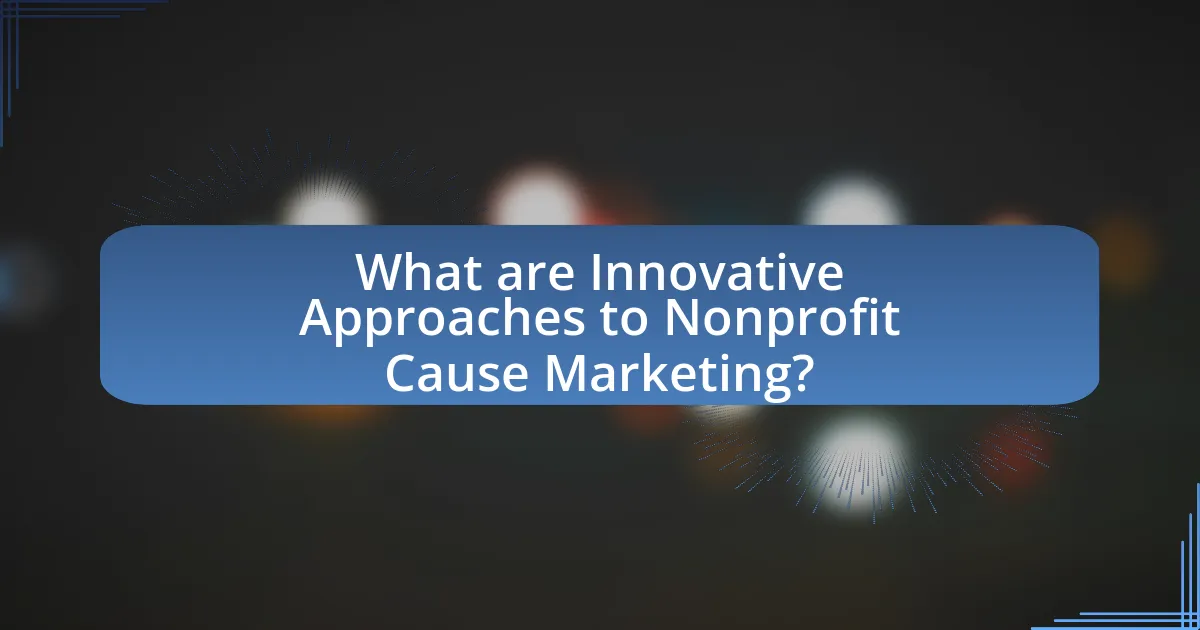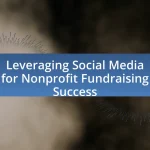The article focuses on innovative approaches to nonprofit cause marketing, highlighting strategies such as leveraging social media influencers, utilizing data analytics, and creating immersive experiences through virtual reality. It contrasts these methods with traditional cause marketing, emphasizing engagement and collaboration over transactional relationships. Key characteristics of innovative approaches include creativity, adaptability, and collaboration, which are essential for enhancing donor engagement and brand awareness. The article also addresses the importance of innovation in driving fundraising success, the challenges nonprofits face in implementing these strategies, and best practices for measuring campaign effectiveness and fostering a culture of innovation.

What are Innovative Approaches to Nonprofit Cause Marketing?
Innovative approaches to nonprofit cause marketing include leveraging social media influencers, utilizing data analytics for targeted campaigns, and creating immersive experiences through virtual reality. Social media influencers can amplify a nonprofit’s message, reaching wider audiences and engaging younger demographics effectively. Data analytics allows organizations to tailor their marketing strategies based on audience behavior and preferences, enhancing engagement and donation rates. Additionally, virtual reality experiences can create emotional connections by immersing potential donors in the cause, leading to increased empathy and support. These methods have been shown to improve fundraising outcomes and raise awareness significantly.
How do these approaches differ from traditional cause marketing?
Innovative approaches to nonprofit cause marketing differ from traditional cause marketing primarily in their focus on engagement and collaboration rather than mere transactional relationships. Traditional cause marketing often involves a straightforward exchange where a company donates a portion of sales to a cause, primarily driven by profit motives. In contrast, innovative approaches emphasize building long-term partnerships with nonprofits, fostering community involvement, and creating shared value. For instance, companies may engage in co-creation of campaigns with nonprofits, leveraging social media for interactive storytelling, which enhances emotional connections and encourages active participation from consumers. This shift is supported by research indicating that 70% of consumers prefer brands that align with social causes, highlighting the effectiveness of these innovative strategies in driving consumer loyalty and brand differentiation.
What are the key characteristics of innovative approaches?
Key characteristics of innovative approaches include creativity, adaptability, and collaboration. Creativity drives the generation of unique ideas and solutions that differentiate an organization in the nonprofit sector. Adaptability allows organizations to respond effectively to changing environments and stakeholder needs, ensuring relevance and impact. Collaboration fosters partnerships and collective efforts, enhancing resource sharing and maximizing outreach. These characteristics are essential for nonprofits to effectively engage audiences and achieve their mission in a competitive landscape.
Why is innovation important in nonprofit cause marketing?
Innovation is important in nonprofit cause marketing because it enables organizations to differentiate themselves and effectively engage their target audiences. In a competitive landscape, innovative strategies can capture attention, foster emotional connections, and drive donor engagement. For instance, a study by the Nonprofit Marketing Guide found that nonprofits that adopt innovative marketing techniques see a 30% increase in donor retention rates compared to those that do not. This demonstrates that innovation not only enhances visibility but also strengthens relationships with supporters, ultimately leading to greater impact and sustainability for the cause.
What are the benefits of adopting innovative approaches?
Adopting innovative approaches in nonprofit cause marketing enhances engagement and effectiveness. These approaches allow organizations to connect with audiences in unique ways, increasing visibility and support for their causes. For instance, a study by the Stanford Social Innovation Review found that nonprofits employing innovative strategies saw a 30% increase in donor engagement compared to traditional methods. Additionally, innovative approaches can lead to more efficient resource allocation, as they often leverage technology and creative partnerships, resulting in a 25% reduction in operational costs, according to research by the Nonprofit Finance Fund.
How do these approaches enhance donor engagement?
Innovative approaches to nonprofit cause marketing enhance donor engagement by creating personalized and meaningful connections between donors and the causes they support. These strategies often utilize data analytics to tailor communication and outreach efforts, ensuring that messages resonate with individual donor values and interests. For instance, a study by the Nonprofit Research Collaborative found that organizations employing targeted marketing strategies saw a 20% increase in donor retention rates, demonstrating the effectiveness of personalized engagement in fostering long-term relationships.
What impact do they have on brand awareness for nonprofits?
Innovative approaches to nonprofit cause marketing significantly enhance brand awareness for nonprofits. These strategies leverage partnerships, social media campaigns, and community engagement to increase visibility and recognition. For instance, a study by the Nonprofit Marketing Guide found that 70% of nonprofits reported increased brand awareness through collaborative campaigns with businesses. This demonstrates that effective cause marketing not only raises funds but also elevates the nonprofit’s profile in the community, leading to greater public recognition and support.

What strategies are considered innovative in nonprofit cause marketing?
Innovative strategies in nonprofit cause marketing include leveraging social media influencers, utilizing data analytics for targeted campaigns, and creating immersive experiences through virtual reality. Social media influencers can amplify a nonprofit’s message by reaching diverse audiences, as seen in campaigns like the ALS Ice Bucket Challenge, which raised over $115 million. Data analytics allows organizations to tailor their messaging and outreach efforts, enhancing engagement and donor retention. Additionally, immersive experiences, such as virtual reality storytelling, can evoke emotional responses and foster deeper connections with potential supporters, exemplified by initiatives like the UN’s “The World is Watching” campaign, which effectively raised awareness for global issues.
How can storytelling be utilized effectively?
Storytelling can be utilized effectively in nonprofit cause marketing by creating emotional connections that resonate with the audience. This approach engages potential donors and supporters by illustrating the impact of their contributions through relatable narratives. For instance, a study by the Stanford Graduate School of Business found that stories can increase the likelihood of donations by 30% compared to statistics alone, as they evoke empathy and personal investment in the cause. By focusing on individual experiences and outcomes, nonprofits can enhance their messaging and drive engagement, ultimately leading to increased support and funding.
What elements make a compelling story for cause marketing?
A compelling story for cause marketing includes emotional connection, authenticity, relatability, and a clear call to action. Emotional connection engages the audience by evoking feelings that resonate with their values and beliefs, making them more likely to support the cause. Authenticity builds trust; stories that are genuine and transparent about the cause and its impact encourage deeper engagement. Relatability allows the audience to see themselves in the story, fostering a personal connection to the cause. A clear call to action provides direction, motivating the audience to take specific steps to support the initiative. Research indicates that narratives incorporating these elements can significantly enhance audience engagement and drive donations, as evidenced by a study from the Stanford Social Innovation Review, which found that storytelling can increase donations by up to 300%.
How does storytelling influence donor behavior?
Storytelling significantly influences donor behavior by creating emotional connections that drive engagement and support. When nonprofits share compelling narratives about their mission, beneficiaries, and impact, they evoke empathy and inspire action among potential donors. Research indicates that emotional storytelling can increase donations by up to 50%, as it helps donors visualize the difference their contributions can make. For instance, a study published in the Journal of Nonprofit & Public Sector Marketing found that stories that highlight individual beneficiaries lead to higher donation amounts compared to statistics alone. This demonstrates that effective storytelling not only captures attention but also motivates financial support by fostering a sense of personal involvement and urgency in the donor.
What role does technology play in innovative cause marketing?
Technology plays a crucial role in innovative cause marketing by enabling organizations to engage audiences more effectively and efficiently. Through digital platforms, nonprofits can leverage social media, mobile applications, and data analytics to reach wider audiences, personalize messaging, and track campaign performance in real-time. For instance, a study by the Nonprofit Technology Network found that 70% of nonprofits reported increased engagement through social media campaigns, demonstrating technology’s impact on outreach and donor interaction. Additionally, tools like crowdfunding platforms have revolutionized fundraising, allowing for direct contributions from supporters, which enhances community involvement and transparency.
How can social media platforms be leveraged for campaigns?
Social media platforms can be leveraged for campaigns by utilizing targeted advertising, engaging content, and community building. Targeted advertising allows organizations to reach specific demographics, increasing the likelihood of engagement; for instance, Facebook’s ad platform enables precise targeting based on user interests and behaviors. Engaging content, such as videos and infographics, can capture attention and encourage sharing, which amplifies reach; studies show that visual content is 40 times more likely to be shared than other types. Community building fosters relationships with supporters, enhancing loyalty and encouraging grassroots advocacy; for example, campaigns that encourage user-generated content can create a sense of ownership among participants. These strategies collectively enhance campaign effectiveness and drive measurable results.
What are the benefits of using data analytics in marketing strategies?
The benefits of using data analytics in marketing strategies include enhanced targeting, improved customer insights, and increased ROI. Enhanced targeting allows marketers to identify specific audience segments, leading to more personalized campaigns that resonate with potential donors. Improved customer insights derived from data analytics enable organizations to understand donor behavior and preferences, facilitating tailored messaging and engagement strategies. Additionally, data analytics can significantly increase ROI by optimizing marketing spend; for instance, organizations that leverage data-driven strategies can see up to a 15-20% increase in marketing effectiveness, as evidenced by a study from the Harvard Business Review, which highlights the correlation between data utilization and marketing performance.

What challenges do nonprofits face when implementing innovative approaches?
Nonprofits face several challenges when implementing innovative approaches, primarily including limited funding, resistance to change, and lack of technical expertise. Limited funding restricts the ability to invest in new technologies or programs, which can hinder innovation. Resistance to change often arises from staff or stakeholders who are accustomed to traditional methods, making it difficult to adopt new strategies. Additionally, a lack of technical expertise can prevent nonprofits from effectively utilizing innovative tools or methodologies, as many organizations may not have the necessary skills in-house. These challenges collectively impede the successful implementation of innovative approaches in nonprofit cause marketing.
How can resource limitations affect innovation?
Resource limitations can significantly hinder innovation by restricting the availability of financial, human, and technological resources necessary for developing new ideas. When organizations face budget constraints, they often prioritize immediate operational needs over long-term innovative projects, leading to a lack of investment in research and development. For instance, a study by the National Bureau of Economic Research found that firms with limited financial resources are less likely to engage in innovative activities, as they cannot afford the risks associated with experimentation and new product development. Consequently, resource limitations can stifle creativity and slow down the pace of innovation, ultimately affecting an organization’s ability to adapt and thrive in a competitive environment.
What strategies can nonprofits use to overcome these limitations?
Nonprofits can overcome limitations by leveraging partnerships, enhancing digital marketing strategies, and diversifying funding sources. Collaborating with businesses can provide access to resources and expertise, while effective digital marketing can increase visibility and engagement with potential donors. Additionally, diversifying funding sources, such as grants, individual donations, and corporate sponsorships, can reduce reliance on a single income stream, thereby increasing financial stability. These strategies are supported by research indicating that nonprofits that engage in partnerships and utilize digital platforms see higher engagement rates and funding success.
How does organizational culture impact innovation adoption?
Organizational culture significantly impacts innovation adoption by shaping employees’ attitudes towards change and risk-taking. A culture that encourages open communication, collaboration, and experimentation fosters an environment where innovative ideas can thrive. For instance, companies like Google and 3M have been successful in adopting innovations due to their cultures that promote creativity and allow employees to dedicate time to pursue personal projects. Research indicates that organizations with a strong culture of innovation experience 30% higher rates of successful innovation adoption compared to those with a more traditional culture (Source: “The Innovation Culture: How to Build a Culture of Innovation,” Harvard Business Review, authors: Ed. Catmull, and others). This demonstrates that a supportive organizational culture is crucial for effectively integrating new ideas and practices.
What ethical considerations must be addressed?
Ethical considerations in nonprofit cause marketing include transparency, accountability, and the potential for exploitation. Nonprofits must ensure that their partnerships with corporations are clearly communicated to stakeholders, avoiding any misleading representations about the nature of the collaboration. Accountability involves the responsible use of funds raised through cause marketing campaigns, ensuring that a significant portion directly benefits the intended cause rather than administrative costs. Additionally, the risk of exploitation arises when nonprofits may inadvertently prioritize corporate interests over their mission, potentially compromising their integrity and the trust of their supporters. These considerations are crucial to maintaining ethical standards and fostering public trust in nonprofit organizations.
How can nonprofits ensure transparency in their marketing efforts?
Nonprofits can ensure transparency in their marketing efforts by clearly communicating their goals, strategies, and financial allocations to stakeholders. This involves providing detailed information about how funds are used, sharing success stories, and being open about challenges faced. For instance, a study by the Nonprofit Finance Fund found that 70% of donors prefer organizations that are transparent about their financial health and program effectiveness. By utilizing tools such as annual reports, social media updates, and third-party evaluations, nonprofits can build trust and demonstrate accountability, which is essential for fostering donor confidence and engagement.
What are the potential risks of innovative cause marketing?
The potential risks of innovative cause marketing include brand misalignment, consumer skepticism, and backlash from stakeholders. Brand misalignment occurs when the cause does not resonate with the brand’s core values, leading to a disconnect that can damage brand reputation. Consumer skepticism arises when audiences perceive the marketing as insincere or exploitative, which can result in negative public perception and reduced trust. Backlash from stakeholders, including customers, employees, and advocacy groups, can occur if the cause is controversial or if the marketing strategy is seen as opportunistic rather than genuinely supportive. These risks highlight the importance of aligning marketing strategies with authentic values and ensuring transparency in cause-related initiatives.
What are best practices for successful implementation of innovative approaches?
Successful implementation of innovative approaches in nonprofit cause marketing requires a clear strategy, stakeholder engagement, and continuous evaluation. A well-defined strategy aligns innovative initiatives with organizational goals, ensuring that efforts are focused and measurable. Engaging stakeholders, including beneficiaries, donors, and community members, fosters collaboration and buy-in, which is essential for the success of new initiatives. Continuous evaluation through metrics and feedback loops allows organizations to assess the effectiveness of their innovative approaches and make necessary adjustments. Research indicates that nonprofits that actively involve stakeholders and adapt based on feedback are more likely to achieve their objectives and sustain their innovations over time.
How can nonprofits measure the effectiveness of their campaigns?
Nonprofits can measure the effectiveness of their campaigns through various metrics such as donor engagement, campaign reach, and conversion rates. By analyzing data from social media interactions, email open rates, and website traffic, organizations can assess how well their messaging resonates with the target audience. For instance, a study by the Nonprofit Marketing Guide found that 70% of nonprofits reported using metrics like donor retention rates and fundraising totals to evaluate campaign success. Additionally, tools like Google Analytics can provide insights into user behavior, helping nonprofits understand which aspects of their campaigns are most effective.
What tips can help nonprofits foster a culture of innovation?
Nonprofits can foster a culture of innovation by encouraging open communication and collaboration among staff and stakeholders. This approach allows diverse ideas to emerge and be evaluated, leading to creative solutions. Additionally, providing training and resources for staff to develop new skills can enhance their ability to think innovatively. Research shows that organizations with a strong emphasis on employee engagement and empowerment are more likely to implement successful innovative practices. For example, a study by the Harvard Business Review found that companies that prioritize innovation see a 20% increase in employee satisfaction and a 30% increase in productivity.


